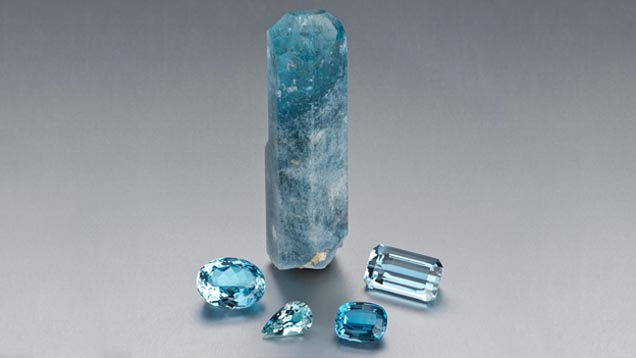About Aquamarine
My favorite colour is something in between blue and green.
So when I saw an aquamarine for the first time it was mesmerizing.
It's like grabing a bit of blue sky, a bit of sea water and a bit of
sun light, mixing it and cristallizing it into a gorgeous mineral...
What is it?

Aquamarine is a variety of a mineral named Beryl. Another well known variety of Beryl is Emerald.
Aquamarine colours
can vary from sky-blue to sea-green.
More info
In ancient times, in the Mediterranean sea, aquamarine was thought to be a treasure from the mermaids. It was used by fishermen, navigators and travelers as a lucky amulet.
What is it made of?
Beryl gained it's name for being rich in a metal named Beryllium. "Chemically" speaking, beryls are beryllium aluminosilicates. Which is to say beryl refers to a group of minerals formed by silicates (SiO4), aluminium (Al) and Beryllium (Be).
More infoIn this aluminosilicates group, beryl is included in another group, the cyclosilicates because its atoms are organized in little tetraedrons that bound with each other to form a ring. A beryl is a six-member ring cyclosilicate.
More info
Where does it come from?

Aquamarine major extracted deposits are currently located in:
- Brazil
- China
- India
- Kenya
- Madagascar
- Mozambique
- Myanmar
- Nigeria
- Pakistan
- Tanzanya
- Vietnam
- Zambia
- Zimbabwe
- More info
How does it turn into a gem?

Aquamarines are frequently submited to a heat treatment in order
to highlight it's blue color.
The seagreen variety is also very appreciated as well as all the
colours in between.
Heat treatment provokes changes at the
atomic level that are translated into changes in colour and other
properties.
The image shows that until 700ºC the aquamarine color changes due to
the reduction of iron. Reduction is the name of a phenomenon that
happens at the atomic level, where atoms (ions) loose electrons. It's
the oposite of oxidation.
For the Human eye, that's reflected in the aquamarine color change.
It changes from a iron oxidated state (sea-green), to an iron
reduced state(deep-blue).
Above 700ºC, aquamarine starts dehidratating and oxidating, loosing
it's bluish colour and starting to crack.

In the end they're cut, shapped and polished in order to reflect the light that goes through it as much as possible and to seduce the Human eye to buy it 👀
«I wasn't a picky person until I build this webpage. I might become a
monster if I keep going with this...»
🤔
Sofia